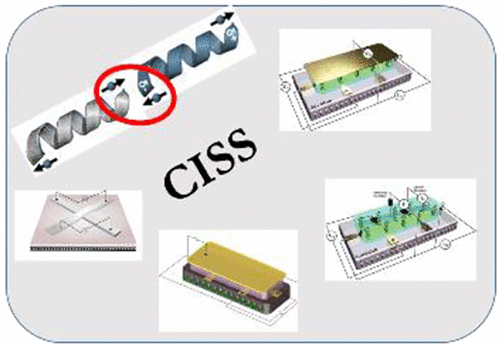当前位置:
X-MOL 学术
›
Acc. Chem. Res.
›
论文详情
Our official English website, www.x-mol.net, welcomes your feedback! (Note: you will need to create a separate account there.)
Chiral Induced Spin Selectivity Gives a New Twist on Spin-Control in Chemistry
Accounts of Chemical Research ( IF 18.3 ) Pub Date : 2020-10-12 , DOI: 10.1021/acs.accounts.0c00485 Ron Naaman 1 , Yossi Paltiel 2 , David H. Waldeck 3
Accounts of Chemical Research ( IF 18.3 ) Pub Date : 2020-10-12 , DOI: 10.1021/acs.accounts.0c00485 Ron Naaman 1 , Yossi Paltiel 2 , David H. Waldeck 3
Affiliation

|
The electron’s spin, its intrinsic angular momentum, is a quantum property that plays a critical role in determining the electronic structure of molecules. Despite its importance, it is not used often for controlling chemical processes, photochemistry excluded. The reason is that many organic molecules have a total spin zero, namely, all the electrons are paired. Even for molecules with high spin multiplicity, the spin orientation is usually only weakly coupled to the molecular frame of nuclei and hence to the molecular orientation. Therefore, controlling the spin orientation usually does not provide a handle on controlling the geometry of the molecular species during a reaction. About two decades ago, however, a new phenomenon was discovered that relates the electron’s spin to the handedness of chiral molecules and is now known as the chiral induced spin selectivity (CISS) effect. It was established that the efficiency of electron transport through chiral molecules depends on the electron spin and that it changes with the enantiomeric form of a molecule and the direction of the electron’s linear momentum. This property means that, for chiral molecules, the electron spin is strongly coupled to the molecular frame. Over the past few years, we and others have shown that this feature can be used to provide spin-control over chemical reactions and to perform enantioseparations with magnetic surfaces.
中文翻译:

手性诱导的自旋选择性为化学自旋控制提供了新的思路
电子的自旋,即其固有的角动量,是一种量子特性,在决定分子的电子结构中起着至关重要的作用。尽管它很重要,但它并不经常用于控制化学过程,光化学除外。原因是许多有机分子的总自旋为零,即所有电子都成对存在。即使对于具有高自旋多重性的分子,自旋取向通常也仅与核的分子框架弱耦合,因此与分子取向弱耦合。因此,控制自旋取向通常不能提供控制反应期间分子种类的几何形状的方法。但是,大约在二十年前 发现了一种新现象,该现象将电子的自旋与手性分子的旋性相关联,现在称为手性诱导的自旋选择性(CISS)效应。已经确定,电子通过手性分子的传输效率取决于电子自旋,并且其随分子的对映体形式和电子线性动量的方向而变化。该特性意味着,对于手性分子,电子自旋与分子框架牢固耦合。在过去的几年中,我们和其他人已经表明,此功能可用于提供对化学反应的自旋控制并与磁性表面进行对映体分离。已经确定,电子通过手性分子的传输效率取决于电子自旋,并且其随分子的对映体形式和电子线性动量的方向而变化。该特性意味着,对于手性分子,电子自旋与分子框架牢固耦合。在过去的几年中,我们和其他人已经表明,此功能可用于提供对化学反应的自旋控制并与磁性表面进行对映体分离。已经确定,电子通过手性分子的传输效率取决于电子自旋,并且其随分子的对映体形式和电子线性动量的方向而变化。该特性意味着,对于手性分子,电子自旋与分子框架牢固耦合。在过去的几年中,我们和其他人已经表明,此功能可用于提供对化学反应的自旋控制并与磁性表面进行对映体分离。
更新日期:2020-11-17
中文翻译:

手性诱导的自旋选择性为化学自旋控制提供了新的思路
电子的自旋,即其固有的角动量,是一种量子特性,在决定分子的电子结构中起着至关重要的作用。尽管它很重要,但它并不经常用于控制化学过程,光化学除外。原因是许多有机分子的总自旋为零,即所有电子都成对存在。即使对于具有高自旋多重性的分子,自旋取向通常也仅与核的分子框架弱耦合,因此与分子取向弱耦合。因此,控制自旋取向通常不能提供控制反应期间分子种类的几何形状的方法。但是,大约在二十年前 发现了一种新现象,该现象将电子的自旋与手性分子的旋性相关联,现在称为手性诱导的自旋选择性(CISS)效应。已经确定,电子通过手性分子的传输效率取决于电子自旋,并且其随分子的对映体形式和电子线性动量的方向而变化。该特性意味着,对于手性分子,电子自旋与分子框架牢固耦合。在过去的几年中,我们和其他人已经表明,此功能可用于提供对化学反应的自旋控制并与磁性表面进行对映体分离。已经确定,电子通过手性分子的传输效率取决于电子自旋,并且其随分子的对映体形式和电子线性动量的方向而变化。该特性意味着,对于手性分子,电子自旋与分子框架牢固耦合。在过去的几年中,我们和其他人已经表明,此功能可用于提供对化学反应的自旋控制并与磁性表面进行对映体分离。已经确定,电子通过手性分子的传输效率取决于电子自旋,并且其随分子的对映体形式和电子线性动量的方向而变化。该特性意味着,对于手性分子,电子自旋与分子框架牢固耦合。在过去的几年中,我们和其他人已经表明,此功能可用于提供对化学反应的自旋控制并与磁性表面进行对映体分离。



























 京公网安备 11010802027423号
京公网安备 11010802027423号